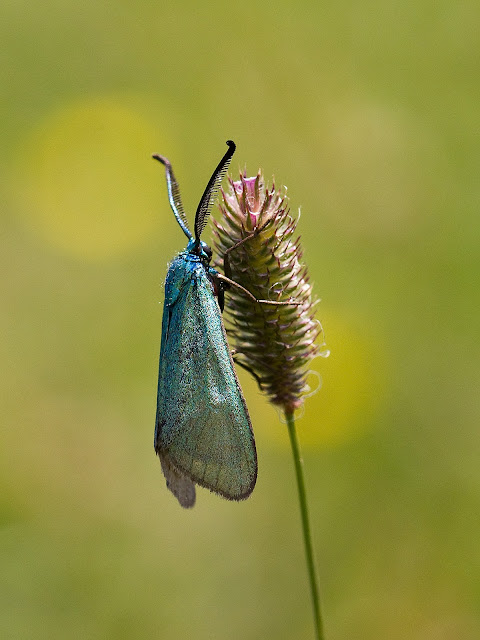After last weeks negative results from our search for Grayling butterflies, Wednesday left us with a choice to make, a return visit to Windover Hill or go looking for Purple Emperors. There wasn't really any choice, the Grayling are a much more interesting target. It is a butterfly that is just hanging on in Sussex and each year we return there is a real fear that it will be gone.
The walk up the hill gave us a good selection of butterflies with a lot more Chalkhill Blues on show than last time although still not in the numbers we had seen some years.
 |
| Chalkhill Blue |
Still hundreds and probably thousands of the nationally rare Yellow Pearl moth and one I forgot to mention in the last blog, sightings of the Forester moth on both visits although only one specimen on each day.
 |
| Yellow Pearl - Mecyna flavalis |
 |
| Six-spot Burnet |
Reaching the top of the hill we crossed over into Deep Dean. We have two strategies for the search. The first and certainly the easiest on a hot day is to sit at the top of the slope and scan for Grayling flying up to intercept any other butterfly passing through their territory. It usually works but not today. The second is to walk up and down the slope looking for the cryptically camouflaged and hard to spot butterfly in each of the scrapes on the hill. It sometimes works but again not today and it was certainly a lot harder work in the midday heat.
We did see a couple of possibles flying. They always remind me of Kestrels. They hang in the wind appearing to be stationary then drop one wing and shoot off down the hill at speed and with no wing flapping. A good possibility it might have been but it was a long way down and the butterfly would not be easy to find to confirm the sighting.
We had lunch and watched for a bit longer but were really ready to head for home. Fortunately we spotted Patrick Moore heading up the hill on his transect. We had spoken to him the week before when he had also drawn a blank. We expected the same response this time but he had seen about a dozen in the bushes at the top of the hill.
You learn something every day, this is not a place we would have looked for the Grayling. Better still, when we walked back up the hill Patrick picked one out from about 20 yards away, a remarkable spot given the jumble of undergrowth there.
We saw three, possibly four Grayling and Patrick had a dozen. It's not many but at least they are still hanging on and we can look forward to seeing them again next year.






















